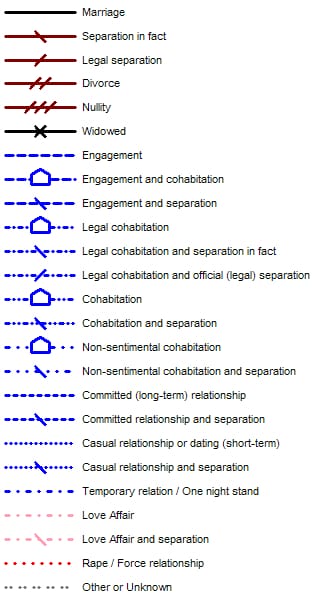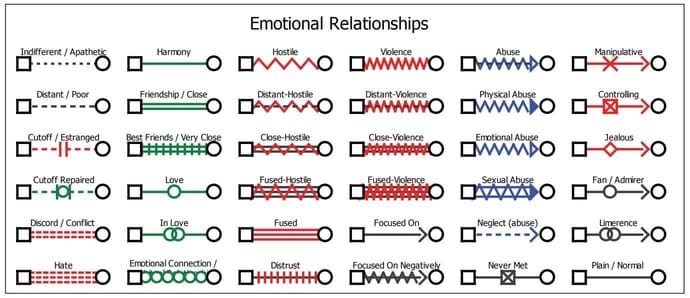How to Make a Genogram – 3 Steps
A genogram can look sophisticated with its many lines and shapes but that doesn’t mean you don’t have the capability to create one yourself. Here are the steps to follow on how to make a genogram and the points you have to remember during and after constructing one.
Steps in Making a Genogram
We’ve divided the construction of a genogram into 3 main steps.
Step 1: Determine your purpose
Why are you making a genogram? What’s it for? Genograms can be used to identify hereditary patterns, genetic diseases, religious affiliations, and relationship quality.
How will you use it? Is it for a school project or for a healthcare provider? Or maybe it’s a personal venture and you just want to know more about your family? Genograms can reveal not only physical but also emotional relationships between the members of the family. Personal and sensitive information might be included in the genogram so you should know whom you’ll be sharing it with to identify which parts should remain confidential.
Knowing your purpose for making a Genogram will also make it easier for you to determine the kinds of information you need to look for. You’ll also have an idea who to approach and how to introduce the questions to them.
Sometimes, family members are not too open to talk about sensitive topics. Providing them context on how you’ll be using such information might make them more amicable with sharing personal info with you.
Also, ask yourself how extensive you want your genogram to be. Normally, people include two to three generations on their genograms. There may be constraints on the availability of contact persons where you can get firsthand information, so you should also consider this factor before constructing one.
Step 2: Start gathering information
Before you set out and gather data, it’s best to formulate a set of questions that will help you extract the needed information as quickly, as accurate, and as detailed as possible.
To whom are your relatives married to? How many siblings does each family member have? Is there any history of drug or alcohol abuse in the family? How about the occurrence of heart attack, diabetes, and the appearance of other genetic diseases? Questions like these will directly give you the answers you’re looking for.
You probably already know more than a thing or two about your family, relatives, and the people listed in your genogram. Look at your questionnaire, write down everything you can remember, and see how much you can answer on your own. You’ll be able to further narrow down the questions you need to ask as you’ve probably answered many of them in the process.
Seek documents, family books, albums, medical records,or even the internet to gather more info about your family. You can also use these reference materials for cross-checking what you’ll learn from interviewing family members.
When you’ve exhausted every resource material and have jutted down everything you can remember, it’s time you go out and ask the other members to help you fill in the gaps on your genogram.
Start with those closest to you first. They’ll be more comfortable talking to you and you’ll most likely extract more information from them about the other family members.
Be ready to listen to a lot of stories. In fact, you should motivate them to share personal accounts by attentively listening to what they’re saying and following-up with open-ended questions that will bring forth more information.
Some stories may be irrelevant to what you really need but these may contain bits of information you haven’t thought about before. Stories also provide context to the info you have at hand, giving you a better picture of the hows and whys of your family relationships.
The easy part of the interviews is knowing about familial relationships. Who’s married to who? Who are divorced? Anyone separated, widowed, or still single? Answers to these questions just scratch the surface of the story. Going deeper and understanding the underlying factors that led to the current status of affairs is where things get tougher.
Remember that not everybody is a fan of direct approaches that sound too blunt and callous. Time your interview and ask them first if they’re comfortable talking things with you.
Step 3: Construct the genogram
Genograms can look complex, especially if you don’t know the elements that make it up. To make it easier to understand, here’s a breakdown of what you should know and draw first when constructing your genogram.
Know the symbols
Genograms use a variety of symbols to represent family members and their relationship with one another. Males are represented by squares while females by circles. Some even include pets which are represented by the diamond shape.
 Basic genogram symbols
Basic genogram symbols
Simple enough right? It’s in the drawing of the connecting lines where things get interesting.
Entities in the genogram are connected by lines. Solid ones indicate a healthy relationship between the members. Variations can be observed when the family relationship involves separation, divorce, affair, cohabitation, and marriage.
Colors and more animated lines appear when the emotional relationship among the entities in the genogram is described. Symbols for apathy, harmony, hate, love, hostility, abuse, and violence all have distinctive figures that make them easily distinguishable to professionals.
Mental illnesses, medical conditions, and addictions have their own symbol. Deceased members are depicted with a large ‘X’ over their symbols.
Draw the members and connect them with each other
 Symbols for family relationships
Symbols for family relationships
Each generation is drawn below the previous one, with grandparents at the top, parents on the next level below, and the children at the bottommost portion of the genogram. The male parent is always drawn on the left side while the female is on the right. Children also follow a drawing direction, with the eldest placed on the leftmost portion and the youngest on the right in descending birth order.
Genograms can depict the quality of relationships between each family member through the use of lines. Lines can denote marriage, divorce, and other living situations.
The name and age of each member are written inside the shapes. Additional information like the date of marriage, educational background, occupation, and current location can also be included, depending on which of them are relevant to the purpose of your genogram.
Dive deeper into detail
After doing the basic connections, it’s time to delve further into detail and include the specifics of each relationship.
 Symbols for emotional relationships
Symbols for emotional relationships
Emotional connections between each member tell a lot about how aspects like stress, abuse, harmony, and support affect the quality of life of an individual.
Completing your genogram may take quite some time, depending on how expansive and detailed you want it to be. Using software like GenoPro can hasten the task and make the end result clearer and more comprehensive.
Things to Remember
A genogram is an assessment tool that can be used to open up discussion on an individual’s traits, experiences, and relationships. The information written on it should be treated with respect and confidentiality since it may contain materials that also involve other family members.
Genograms depict emotional relationships among family memberswhich can even reveal patterns and facts not everybody knows about. Choose carefully to whom you will divulge sensitive information and spill your findings about your family.
Avoid hastily making assumptions about the findings based on your genogram. The data you have on your hand shouldn’t be used to tell a family member that they have a high chance of suffering from a disease or a mental condition. Do not use the genogram to confront them and prove your point that they need medical help. Consult your personal counselor first before bringing up the conclusions you got from a self-generated genogram.
There are rules on how to draw a genogram. Follow the dos and don’ts to prevent introducing ambiguity, confusion, and misrepresentation in your genogram.
Conclusion
Genograms look complicated because they hold a lot of information in them. Every shape, line, and color denote real-life experiences that affect the character, environment, and lifestyle of an individual.
Constructing a genogram can be done with just a pen and paper but it will be easier if you use software like GenoPro. GenoPro can help you make a clean and comprehensive genogram you can readily present to a health professional for an evaluation.